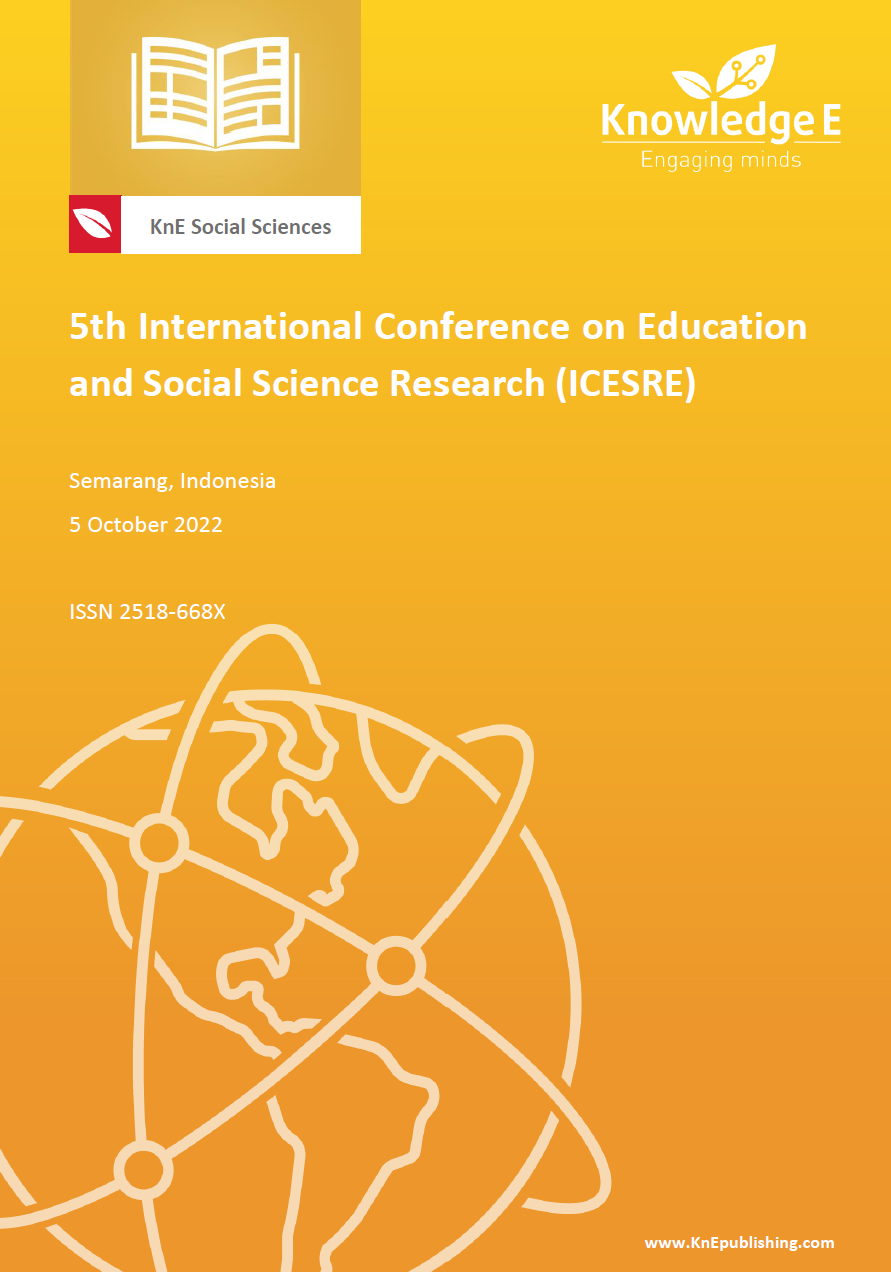Development of Teacher Module for Learning Static Dominant Movement for Students with Autism
DOI:
https://doi.org/10.18502/kss.v7i19.12484Abstract
his research aims to offer solutions to overcome the difficulty of teachers in finding resources for PJOK learning modules in SLB schools. The purpose of this study was to develop a teaching module for learning about static dominant motion for students with autism in class 1 SDLB. This research follows the ADDIE model. A quantitative descriptive data analysis technique was used in this study, while the data was collected using a questionnaire instrument. The research subjects were 9 autistic students and 18 special school teachers. The module has been validated by media experts, material experts, and characteristics experts for autistic children. The results of the large group trial showed a percentage value of 92%. The product of this module was then concluded to be valid and suitable for use by SLB teachers. This module is expected to provide convenience for teachers in teaching autistic students, especially static dominant motion.
Keywords:
References
Lamdan NH, Horesh D, Zohar S, Kraus M, Golan O. Autism spectrum disorder and post-traumatic stress disorder: An unexplored co-occurrence of conditions. Autism. 2020;24:884–898.
Ohara R, Kanejima Y, Kitamura M, Izawa KP. Association between social skills and motor skills in individuals with autism spectrum disorder: A systematic review. European Journal of Investigation in Health, Psychology and Education. 2020;10:276–296.
Oster LM, Zhou G. Balance and vestibular deficits in pediatric patients with autism spectrum disorder: An underappreciated clinical aspect. Autism Research and Treatment. 2022;2022:1–5.
Travers BG, Mason A, Gruben KG, Iii DCD, Mclaughlin K. Autism spectrum : The effects of IQ. Research in Autism Spectrum Disorders. 2018;51:9–17.
Mickle KJ, Munro BJ, Steele JR. Gender and age affect balance performance in primary school-aged children. Journal of Science and Medicine in Sport. 2011;14:243–248.
Phytanza DTP, Purwanta E, Hermanto H, Burhaein E, Demirci N. Floortime approach: Can it improve the learning outcomes of side-rolling exercises for autism spectrum disorder students? Sport Science. 2021;15:141–151.
Fletcher GF, Ades PA, Kligfield P, Arena R, Balady GJ, Bittner VA, et al. Exercise standards for testing and training: A scientific statement from the American heart association. Circulation. 2013;128:873–934.
Yarımkaya E, Esentürk OK. Promoting physical activity for children with autism spectrum disorders during Coronavirus outbreak: Benefits, strategies, and examples. International Journal of Developmental Disabilities. 2022;68:430–435.
Linda R, Herdini H, Ika Sulistya S, Putra TP. Interactive e-module development through chemistry magazine on Kvisoft flipbook maker application for chemistry learning in second semester at second grade senior high school. Journal of Science Learning. 2018;2:21.
Abdul M. Perencanaan Pembelajaran (Mengembangkan Standar Kompetensi Guru). PT Remaja Rosdakarya. 2013.
Rostini D, Zaeni Achmad Syam R, Achmad W. The significance of principal management on teacher performance and quality of learning. AL-ISHLAH Jurnal Pendidik. 2022;14:2513–2520.
Li T, Li Y, Hu Y, Wang Y, Lam CM, Ni W, et al. Heterogeneity of visual preferences for biological and repetitive movements in children with autism spectrum disorder. Autism Research. 2021;14:102–111.
Arslan E, Ince G, Akyüz M. Effects of a 12-week structured circuit exercise program on physical fitness levels of children with autism spectrum condition and typically developing children. International Journal of Developmental Disabilities. 2020;68:500–510.
Utama DDP, Fernando R, Wicaksono L. Learning adaptive physical education in special schools during a pandemic. J MensSana J Ilm Bid Pendidik Olahraga. 2021;6:182–190.
Kurniawan R, Muarifin, Heynoek FP, Sigit CN, Kurniawan AW. Development of teacher e-module for dynamic balance movement for grade 3 elementary school with autism. Proceedings of the 5th International Conference on Sport Science and Health (ICSSH 2021); 2022. p. 98–103.
16. Kurniawan R, Pradana IA, Heynoek FP. Pengembangan modul guru materi variasi dan kombinasi gerak lokomotor non-lokomotor manipulatif untuk siswa autis Development of teacher ’ s module in learning variation and combinations of locomotor. Multilater J Pendidik Jasm dan Olahraga. 2022;21:98–114.
Kurniawan R, Heynoek FP, Wijayanti AW. Pengembangan modul guru pada materi variasi dan kombinasi gerak lokomotor dan manipulatif untuk SMALB. Physical Activity Journal. 2022;3:141.
Kurniawan R, Pambudi S, Heynoek FP. Jurnal pendidikan jasmani Indonesia development of teacher guidelines on non-locomotor. Jurnal Pendidik Jasm Indonesia. 2022;18:57–68.
Kurniawan R, Heynoek FP, Wijaya MAI. Pengembangan modul guru pada pembelajaran materi gerak dasar lokomotor kelas II SDLB autis. Journal-Patriot. 2021;4:71–81.
Branch RM. Instructional design: The ADDIE approach. Instructional design: The ADDIE approach. USA: Springer; 2010. p. 1–203.
Salar S, Daneshmandi H, Ardakani MK, Sharif HN, Salar S. Core strength and balance of children with autism salar. Annals of Applied Sport Science. 2014;2.
Information Analysis Directorate. The prevalence of autism (including Asperger Syndrome) in school age children in Northern Ireland 2017. Information Analysis Directorate; 2017.
Rafei Borujeni M, Talebpoor F, Nezakatalhosseini M, Safavi S. Effect of a period of selected exercises over soft and hard surfaces on the static balance of children with Autism Spectrum disorder. Motor Behavior. 2019;1255–80.
Stins JF, Emck C, de Vries EM, Doop S, Beek PJ. Attentional and sensory contributions to postural sway in children with autism spectrum disorder. Gait Posture. 2015;42:199–203.
Akyol B, Pektaş S. The effects of gymnastics training combined with music in children with Autism Spectrum disorder and Down Syndrome. International Education Studies. 2018;11:46.
Cheldavi H, Shakerian S, Shetab Boshehri SN, Zarghami M. The effects of balance training intervention on postural control of children with autism spectrum disorder: Role of sensory information. Research in Autism Spectrum Disorders. 2014;8:8–14.
Travers BG, Mason AH, Gruben KG, Dean DC, McLaughlin K. Standing balance on unsteady surfaces in children on the autism spectrum: The effects of IQ. Research in Autism Spectrum Disorders. 2018;51:9–17.
Klavina A, Zusa-Rodke A, Galeja Z. The assessment of static balance in children with hearing, visual and intellectual disabilities. Acta Gymnica. 2017;47:105–111.
Fournier KA, Kimberg CI, Radonovich KJ, Tillman MD, Chow JW, Lewis MH, et al. Decreased static and dynamic postural control in children with autism spectrum disorders. Gait Posture. 2010;32:6–9.
Najafabadi MG, Sheikh M, Hemayattalab R, Memari AH, Aderyani MR, Hafizi S. The effect of SPARK on social and motor skills of children with autism. Pediatrics & Neonatology. 2018;59:481–487.

